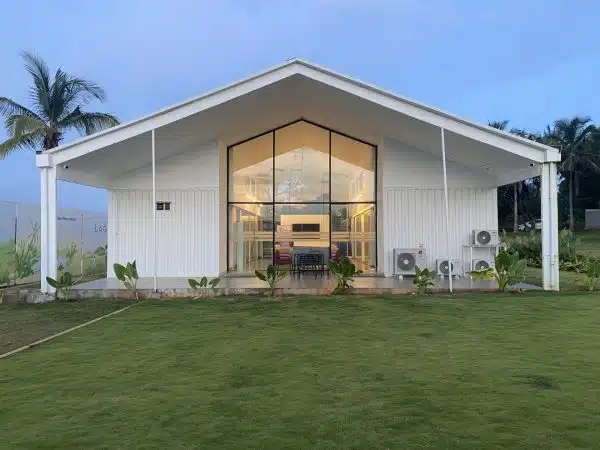Container Offices Price Guide 2025: Smart Costing and ROI for Indian Projects
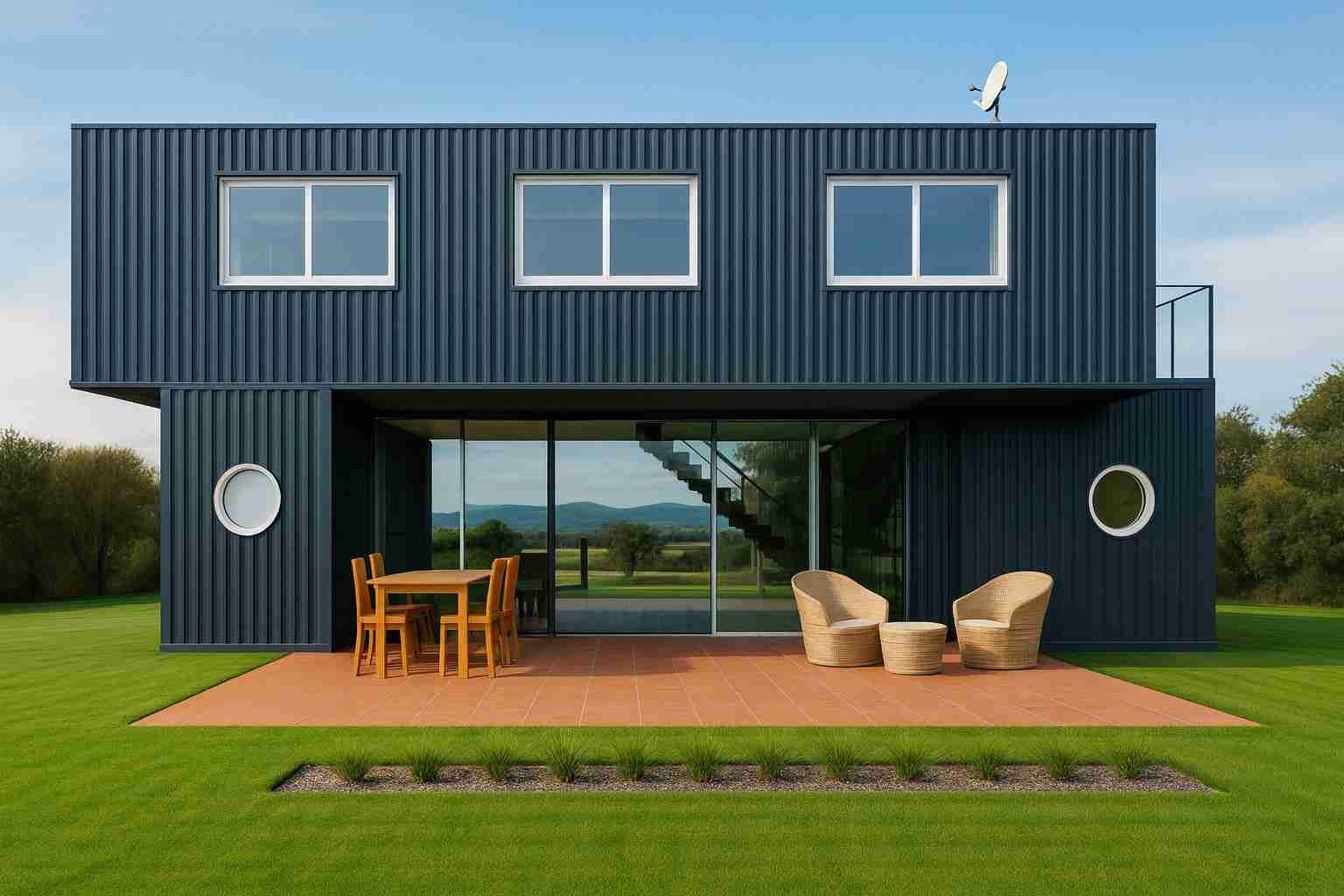
Global Container Office Pricing: Why It Matters in 2025
Container offices price is not a single figure, nor is it limited to one region. In 2025, global buyers face wide price bands depending on container size, condition, and modifications:
| Size / Condition | Price (USD) | Price (EUR) | Typical Use |
| 20 ft Used | $1,500–$3,000 | €1,300–€2,700 | Guard cabins / compact offices |
| 20 ft New (One-Trip) | $2,500–$4,000 | €2,200–€3,500 | Small branded offices |
| 40 ft Used | $2,800–$5,000 | €2,500–€4,500 | Mid-size project HQs |
| 40 ft New (One-Trip) | $3,500–$6,000 | €3,200–€5,500 | Corporate-grade offices |
Beyond the shell, modifications add $5,000–$20,000 worldwide. Features like insulation, HVAC, branded interiors, and compliance documents heavily influence cost.
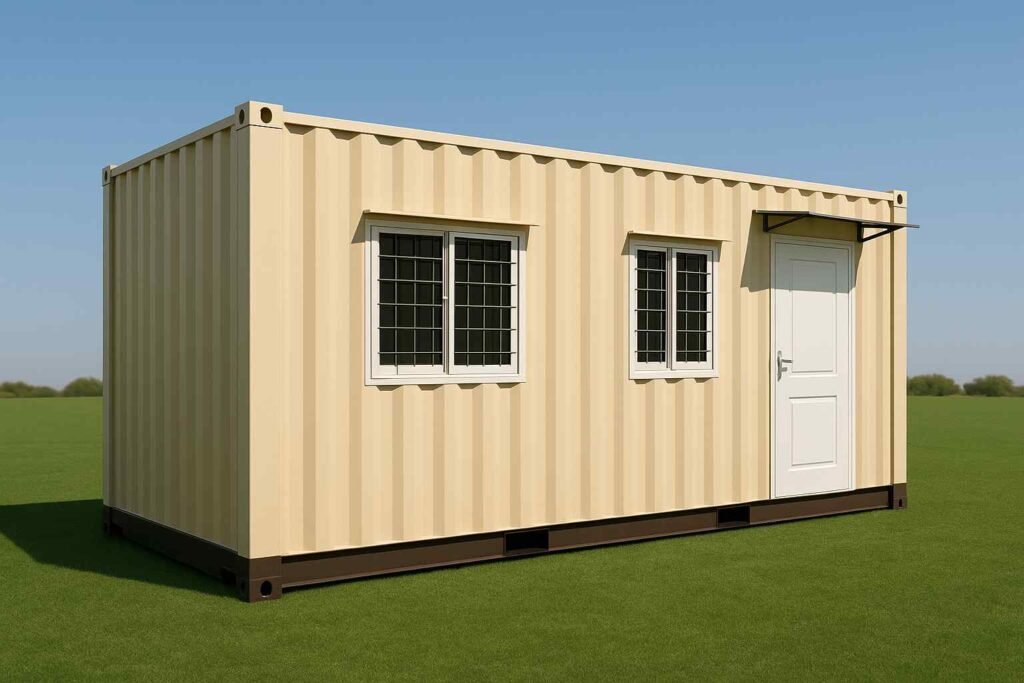
India Case Study
In India, container office pricing follows three tiers:
- Basic 20 ft units: ₹1.7–2.5 lakh
- Standard 30–40 ft units: ₹3–6 lakh
- Premium branded offices: ₹8–15 lakh
Yet price is more than a number. Over five years, container offices in India prove 30–40% cheaper than brick offices, not only because they cost less per square foot but also because they launch projects faster, save on energy, and retain resale value.
Why “Price” Alone Misleads Buyers
When buyers search online for container office price India, they often expect a single fixed number. In reality, cost depends on context, specification, and lifecycle value.
- Project scale matters: A 20 ft guard room in a Tier-II city may cost ₹2 lakh, while a 40 ft corporate sales office in Bengaluru can cross ₹10 lakh due to branding, insulation, and HVAC.
- Materials & interiors matter: Bare shells appear cheaper but deliver poor comfort. Branded interiors raise upfront cost but boost client trust and resale value.
- Supplier credibility matters: Certified suppliers include ISO/CSC plates, warranties, and documentation. Low-cost vendors skip these, leading to failed tenders and hidden expenses.
Why Smart Buyers Look Beyond the Sticker Price
Price is not just today’s outflow; it’s an investment in speed, usability, and resale recovery. A well-built cabin may serve multiple projects, retain 50–70% of its value, and cut electricity bills by 20–30% if insulated properly.
Therefore, the question is not “How cheap is the quote?” but “How much value does this office create over its life?”
The Investment Lens: Why Price Creates Returns
Price should never be viewed as an expense alone. A container office is a revenue enabler that:
- Drives operations: Protects staff, provides functional space, and signals professionalism to clients.
- Accelerates timelines: A standard office delivered in 6 weeks can save months compared to brick builds, allowing sales or site operations to start earlier.
- Improves cash flow: Faster project launch means faster revenue cycles and stronger investor confidence.
India Case Study: Bengaluru Developer
- Initial investment: ₹7 lakh in a branded container office.
- Impact: Sales launched 4 months early, boosting conversions.
- Exit: Resale recovered 60% of cost.
- Effective cost: Just ₹2.8 lakh after recovery.
Why This Matters Globally
Brick buildings worldwide require land, approvals, and long construction schedules. Container offices bypass these bottlenecks, creating usable workspace while projects are still in groundwork stages. For developers in the U.S., Europe, or India, this time advantage often translates into millions in accelerated revenue—far outweighing the upfront price.
Why Costs Vary So Sharply Across India — and Beyond
Container office prices are never uniform, whether in India or globally. Costs shift with region, materials, interiors, and lifecycle goals.
Regional Differences (India)
- Bangalore: ~₹2 lakh for a 20 ft cabin.
- Delhi NCR: ~₹2.3 lakh, driven by higher crane rentals and compliance fees.
- Mumbai: Often higher still due to scarce land and complex logistics.
- Tier-II Cities: Lower labor costs but fewer suppliers and customization options.
Global Comparisons
- U.S.: Midwest projects pay lower transport vs coastal cities like New York or LA.
- Middle East: Crane rentals in Dubai can raise setup costs 20%.
- Europe: Stricter zoning approvals in Germany and France add permit fees.
Materials & Durability
- Corten Steel: Best for coastal India (Kerala, Chennai) and humid zones globally; strong resale demand.
- Mild Steel: Cheaper upfront in India and Africa, but requires frequent repainting.
- FRP: Lightweight, used in parts of Europe for mobile classrooms, but unsuitable for Indian monsoons.
Interiors & Image
- Bare cabins reduce upfront cost but hurt productivity.
- Branded interiors (glass façade, AC, partitions) raise price but add resale appeal and client trust — important for sales offices worldwide.
Lifecycle Considerations
- A two-year Indian construction project may justify a mid-range cabin with resale recovery.
- A five-year European HQ requires premium builds with insulation and certifications.
👉 Bottom Line: Costs vary not just by Indian state but globally — shaped by local labor, logistics, and compliance. Smart buyers treat container offices as long-term assets, not one-time purchases.
Breaking Down the Numbers: What Buyers Actually Pay in 2025
Indian container office costs in 2025 fall into three predictable categories, each tied to specific project needs and ROI expectations:
| Category | Size | Typical Features | Price Range (₹) | Best Use Case |
| Basic | 20 ft | Vinyl flooring, wiring, windows | 1.7–2.5 lakh | Guard cabins, compact site offices |
| Standard | 30–40 ft | Partitions, AC, restroom, workstations | 3–6 lakh | Site headquarters, mid-scale developer offices |
| Premium | 40 ft+ | Glass façade, branded interiors, HVAC, corporate fit-outs | 8–15 lakh | Sales counters, corporate-grade HQs |
How Buyers Should Read These Numbers:
- A basic unit is functional, not image-driven — useful for guard posts or temporary sites.
- A standard unit balances affordability with professionalism, offering comfort for daily operations.
- A premium unit is a front-facing business tool that enhances brand image, attracts clients, and delivers higher resale value.
👉 The right choice depends less on budget alone, and more on how the office will be used, how long it will be needed, and whether resale recovery is a priority.
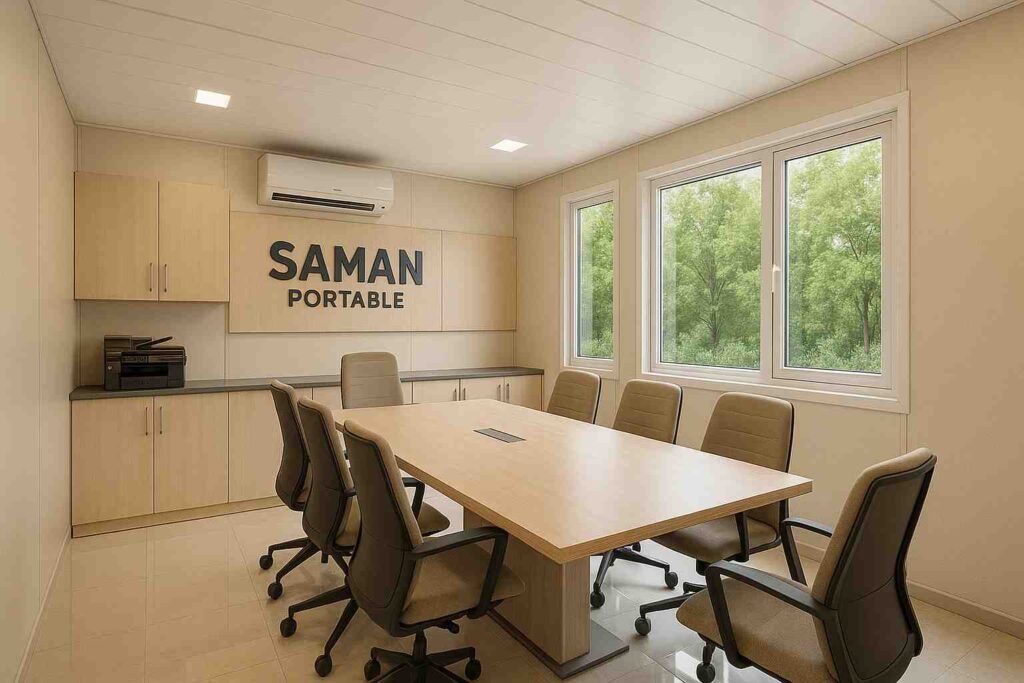
Beyond Sticker Price: The Total Cost of Ownership (TCO)
The price on a quotation is only the beginning. The real cost of a container office comes from four critical lifecycle factors:
- Energy Efficiency
- Insulation reduces HVAC load by 15–30% over 5 years.
- Example: In Gujarat, rock wool cut electricity bills by 25%, saving ₹1 lakh.
- Globally, desert climates (Dubai, Saudi Arabia) achieve similar savings, while European winters demand thicker PUF insulation.
- Maintenance
- Corten Steel: repaint every 5–6 years; low cost, high durability.
- Mild Steel: frequent painting, corrosion risk; savings vanish over time.
- FRP: prone to cracks in monsoon or freezing climates.
- Downtime Avoidance
- Off-site fabrication enables parallel site preparation.
- Example: A U.S. logistics firm saved 3 months of lost rent by installing container offices during warehouse construction.
- In India, faster site office delivery accelerates sales launches.
- Resale Recovery
- Properly maintained units recover 50–70% of purchase price within 3 years.
- India: A ₹7 lakh cabin resold for ₹4 lakh → net cost = ₹3 lakh.
- U.S.: A $12,000 office resold at $6,000 after 3 years → net cost = $6,000.
TCO Example (India)
- Purchase: ₹7 lakh
- Energy Savings (5 years): ₹1 lakh
- Resale Recovery (3 years): ₹4 lakh
- Effective Cost: ₹2 lakh
TCO Example (Global)
- Purchase: $15,000
- Energy Savings (5 years): $3,000
- Resale Recovery (3 years): $7,500
- Effective Cost: $4,500
👉 Key Lesson: The cheapest upfront option (mild steel, no insulation) almost always costs more in the long run. Smart buyers — in India or globally — run lifecycle math before signing.
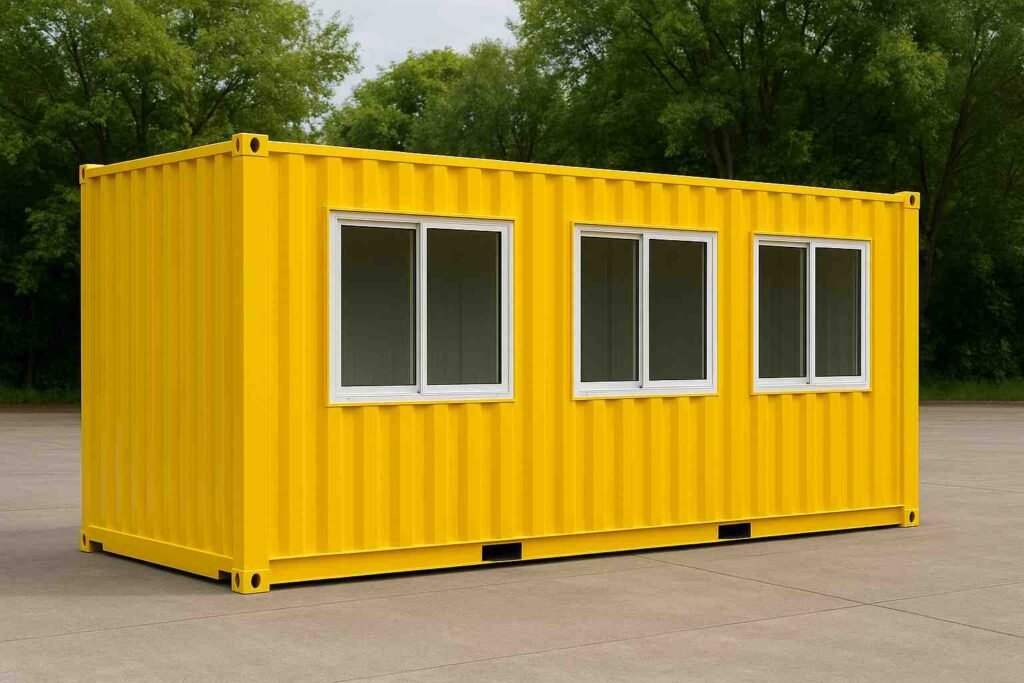
Case Studies: How Container Offices Deliver Real ROI
1. Bengaluru Real Estate Developer – Faster Sales Launch
- Investment: ₹6 lakh on a 30 ft branded sales office.
- Timeline: Delivered in 6 weeks while site groundwork continued.
- Impact: Sales counters opened 6 weeks early, boosting early bookings and investor confidence.
- Exit: Resale recovered ₹3.5 lakh after the project ended.
- Effective Cost: ₹2.5 lakh (a 60% reduction from invoice).
👉 Lesson: Early launch + resale value = superior ROI compared to brick builds or rentals.
2. Delhi Metro – Long-Term Operational Efficiency
- Investment: ₹10 lakh across multiple site offices.
- Usage: Functioned smoothly for 3 years, housing engineers and contractors.
- Savings: No rental dependency; avoided ₹15–18 lakh in equivalent rental outflow.
- Exit: Units resold with 55% recovery value.
- Effective Cost: Less than half of rentals.
👉 Lesson: Large infrastructure projects gain stability + recovery by owning, not renting.
3. Gujarat Renewable Energy Park – Energy Savings in Harsh Climate
- Investment: Higher upfront spend for rock wool insulation in site offices.
- Impact: Reduced HVAC tonnage; electricity bills cut by 25% annually.
- Payback: One-third of office cost recovered in 2 years via energy savings alone.
- ROI: Full payback in 30 months.
👉 Lesson: Insulation turns higher upfront cost into energy-driven ROI.
4. Global Example – U.S. Tech Startup
- Investment: $12,000 for a converted 40 ft office with branding.
- Usage: Served as HQ for 3 years while company scaled.
- Exit: Resold for $6,000.
- Effective Cost: $6,000 net after recovery.
👉 Lesson: Container offices are liquid assets in global resale markets.
5. Global Example – Dubai Logistics Firm
- Investment: $18,000 per insulated 40 ft office for desert worksites.
- Impact: Reduced cooling bills by 20%.
- Timeline: Achieved ROI within 28 months.
- Exit: Cabins redeployed to a new site, retaining 70% usable value.
👉 Lesson: In extreme climates, energy-efficient builds pay for themselves quickly.
Why These Examples Matter
Across India, the U.S., and the Middle East, the same themes emerge:
- Faster launch = earlier revenue.
- Energy efficiency = ongoing savings.
- Resale or redeployment = 50–70% capital recovery.
Key Factors Influencing Container Offices Price in India
Sever No two container office projects are ever priced the same. Costs shift depending on size, material, interiors, insulation, compliance, and location.
- Size & Capacity: Larger cabins may double the upfront cost but can fit triple the workforce, lowering cost-per-person.
- Material Selection: Corten steel, mild steel, and FRP each change durability, upkeep, and resale (see detailed table below).
- Interiors & Branding: Adding partitions, HVAC, or a glass façade raises price but increases productivity and client trust.
- Insulation & Energy Efficiency: Adds to cost but reduces long-term electricity bills by 20–30%.
- Location & Logistics: Prices differ between metros and Tier-II cities because of crane rentals, municipal fees, and transport.
- Compliance & Certification: Certified suppliers charge slightly more but ensure ISO/CSC plates, fire safety, and tender eligibility.
Bottom Line: The smartest buyers don’t chase the lowest quote. They choose features that protect resale value, reduce running costs, and meet compliance—turning price into long-term value.
Size Matters: 20 ft vs 40 ft Offices and Their True Costs
The Size is one of the most visible cost drivers, but its impact goes beyond just the invoice.
| Size | Typical Cost (India, 2025) | Capacity & Use | ROI Impact |
| 20 ft Cabin | ₹1.7–2.5 lakh | Guard rooms, compact teams, temporary offices | Cheaper upfront, but higher cost-per-person |
| 40 ft Cabin | ₹3.5–6 lakh | Site headquarters, mid-sized developer offices | Doubles upfront cost but supports triple workforce → better long-term value |
| 40 ft+ Premium | ₹8–15 lakh | Corporate-grade HQs, branded sales counters | Higher investment, but strong resale + brand credibility |
Why Bigger Often Means Better Value
- A 20 ft cabin saves cash initially, but space quickly becomes a limitation, raising per-head costs.
- A 40 ft cabin, while more expensive, provides efficiency, comfort, and resale recovery.
- Premium 40 ft+ builds not only house staff but also serve as brand assets, impressing clients and boosting sales.
Practical Buyer Insight:
- Tier-II city contractors may start with 20 ft basics for short projects.
- Large developers and tender-based buyers prefer 40 ft or premium units because efficiency, compliance, and resale outweigh upfront savings.
Steel, FRP, or MS? How Materials Decide Lifespan and Budget
Table: Material choices change long‑term performance and pricing in Indian climates.
| Material | Durability | Maintenance | Resale Value | Cost |
| Corten Steel | High corrosion resistance; ideal for coastal states | Low; repaint every 5–6 years | Strong resale demand | Higher initial cost |
| Mild Steel | Moderate; rust risk without upkeep | High; frequent repainting needed | Lower resale appeal | Lower upfront cost |
| FRP | Lightweight; less durable in storms | Moderate; prone to cracks | Low resale demand | Cheapest upfront |
Materials decide both price and durability. Corten steel is strongest. It resists rust, vital for coastal states like Kerala. It also reassures resale buyers. Mild steel looks cheaper initially. But constant painting and repair erode savings.
FRP (fiber reinforced plastic) has niche uses. It is light but fragile. It cannot withstand heavy monsoon winds. Therefore, for long-term use, Corten is safest. Buyers must match material with region. That choice reshapes container offices price India and ensures lifecycle reliability.
Suppliers who use uncertified materials may lower price quotes. But hidden costs later exceed savings. Choosing proper materials means fewer repairs, stronger resale, and predictable performance. Therefore, investing in quality steel ensures projects stay compliant and cost-efficient.
Customization Choices That Add Cost — and Value
Bare shells cost less. But real offices need interiors. Additions like AC, restrooms, or partitions increase cost. Yet, they also increase productivity. They improve employee comfort. They create professional image for clients.
Customization raises prices significantly. A simple ₹2 lakh office can become ₹10 lakh with features. However, these features also increase resale value. Branded interiors and glass facades resell faster. Therefore, customization is both expense and investment.
Contractors working on government tenders often add specific partitions for engineers, managers, and client representatives. Developers use branded designs for marketing value. These investments attract stronger resale demand and speed up deals.
Insulation & Climate Control: The Hidden Saver in Indian Conditions
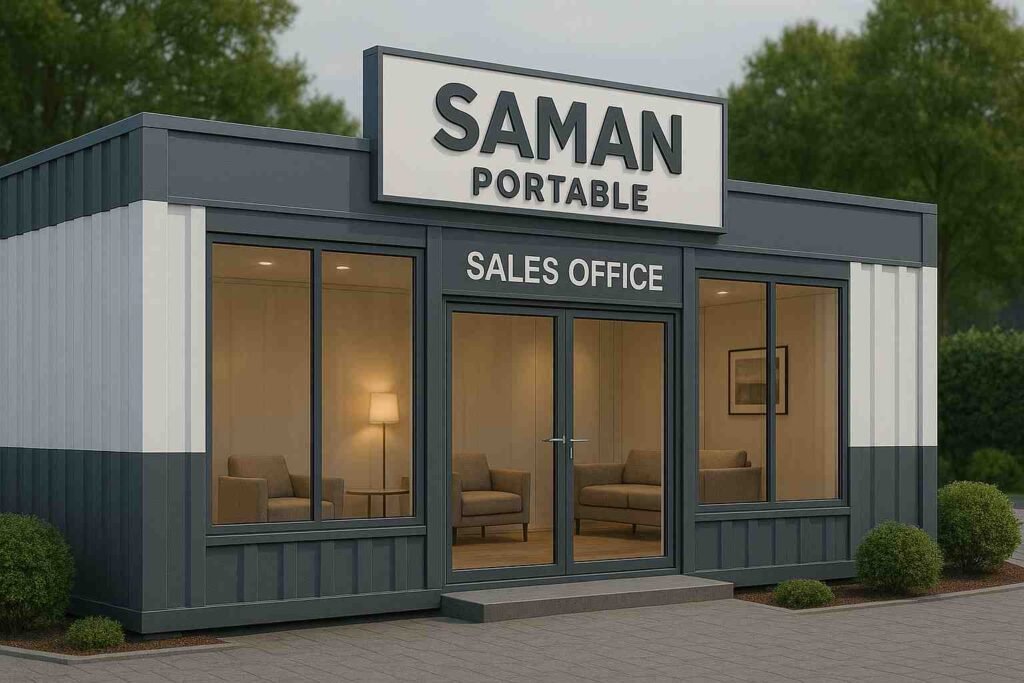
India’s summers hit 45°C. Monsoons flood sites. Insulation makes interiors usable. It adds upfront cost but reduces electricity bills long-term. Glass wool, rock wool, or PUF panels cost more but save energy.
Energy savings reach 15–30%. Over five years, that equals lakhs saved. Comfort also increases staff productivity. Therefore, insulation should be seen as smart spend. When considering container offices price India, insulation is non-negotiable.
Resale buyers also check insulation. Well-insulated cabins sell faster. They fetch better prices. Thus, insulation contributes not only to lower operating expenses but also to stronger capital protection.
Regional Price Gaps: Why Delhi or Mumbai Buyers Pay More
Location changes everything. In Delhi NCR, demand and compliance push prices higher. A 20-foot office may cost ₹2.3 lakh there. The same unit in Bangalore may cost ₹2 lakh. Transport charges add further differences.
Metro cities also face stricter permit rules. That means extra paperwork and fees. Tier-II cities enjoy cheaper labor but limited suppliers. Therefore, buyers must localize budgets. Asking for generic “all India” price is misleading.
Resale markets also differ regionally. Demand is high in metros, which supports better recovery. In Tier-II areas, resale may take longer. Buyers should factor these regional dynamics into planning.
Suppliers, Certifications, and the Real Price of Trust
Compliance is not optional; it shapes both upfront cost and project eligibility. Certified suppliers may charge 5–10% more, but the documents they provide often decide whether a project succeeds or fails.
India Requirements
- ISO Certification (ISO 9001/14001): Confirms quality and environmental standards.
- CSC Safety Plate: Mandatory for containers used in shipping; often demanded in government tenders.
- Fire Safety NOC: Required for sales offices and project HQs with high occupancy.
- Electrical Compliance Certificates: Essential for tenders and resale.
- Structural Drawings & Layout Approvals: Needed for public-sector projects.
👉 Without these, bids are rejected outright, no matter how attractive the price.
Global Requirements
- Europe: CE Marking and EN standards ensure safety and energy compliance.
- U.S.: OSHA regulations + state-specific building permits (zoning, fire, electrical).
- Middle East: Civil Defence approvals and municipality NOCs are mandatory for site installations.
👉 Skipping these adds risk of fines, shutdowns, and resale rejection.
Why Compliance Adds Value
- Tender Eligibility: A 10% higher upfront cost secures projects worth crores.
- Resale Liquidity: Certified cabins resell faster, often within 30–60 days.
- Insurance Approval: Many insurers refuse coverage for uncertified structures.
Bottom Line: Paying slightly more for certified builds is not expense — it’s financial leverage. It protects contracts, resale, and reputation.
Delivery, Installation, and Setup: The Charges Buyers Often Forget
Quotes often ignore setup. But delivery and installation cost real money. Transport varies by distance. Cranes and leveling add more. Foundations also raise price.
Basic setup may add 10% of office cost. Larger projects may add 20%. Buyers must budget honestly. Skipping this step creates overruns.
Therefore, transport and installation are vital when calculating container offices price India. Always ask for detailed itemization before confirming orders.
Branding and Custom Interiors: Spending That Pays Back
Corporate clients often demand branding. Adding company logos, colors, and glass frontages costs extra. But these features improve reputation.
They also strengthen resale demand. For example, a Bengaluru developer branded their office. It impressed clients. Sales accelerated. Later, resale recovered 60% of cost.
Therefore, branding adds both present and future value. For developers and contractors, professional image often decides contract success.
Project Duration: Why Short-Term vs Long-Term Use Alters the Price Equation
Usage duration changes cost logic. For a 6-month project, buyers may choose basic cabins. For a 5-year project, they prefer durable builds.
Longer projects justify higher initial costs. Resale also depends on usage length. A two-year-old cabin retains better value than a five-year-old one.
Therefore, project length must be factored into budget. Ignoring it risks either overspending or underspending.
Checklist for Buyers in 2025
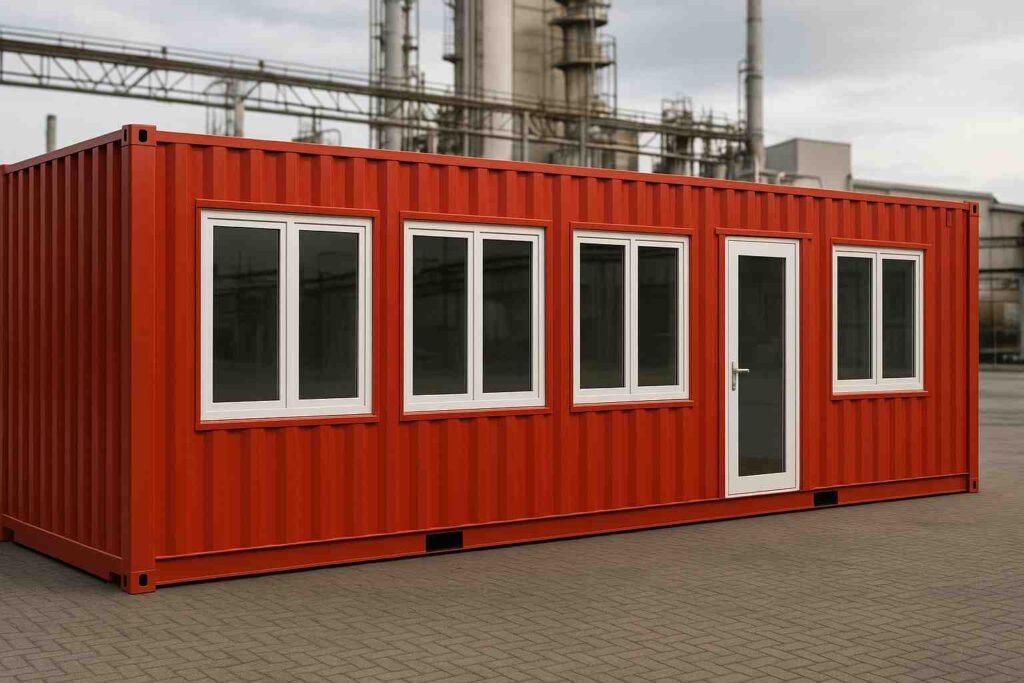
Define size based on headcount. Choose material suitable for climate. Decide interiors required for daily use. Budget insulation for savings. Confirm delivery and installation upfront. Check supplier certifications. Consider project duration and resale plans.
This checklist helps cut confusion. It converts vague quotes into real numbers. It aligns pricing with needs. Buyers who follow this approach achieve predictable ROI and smoother project delivery.
Smart procurement requires structure. Without it, mistakes multiply. With it, every rupee is justified. That discipline makes the container offices price India a reliable, strategic investment.
Price Breakdown for 2025
The container offices price India in 2025 falls into three predictable bands. Basic 20-foot units cost ₹1.7–2.5 lakh, standard 30–40-foot builds go up to ₹6 lakh, while premium corporate setups exceed ₹15 lakh.
Yet, sticker price is only half the truth. Delivery, foundations, and installation create hidden additions. Rentals seem affordable monthly, but ownership creates assets that retain 50–70% resale value. A transparent breakdown helps buyers plan budgets confidently.
The Real Cost Behind Container Offices Price in India
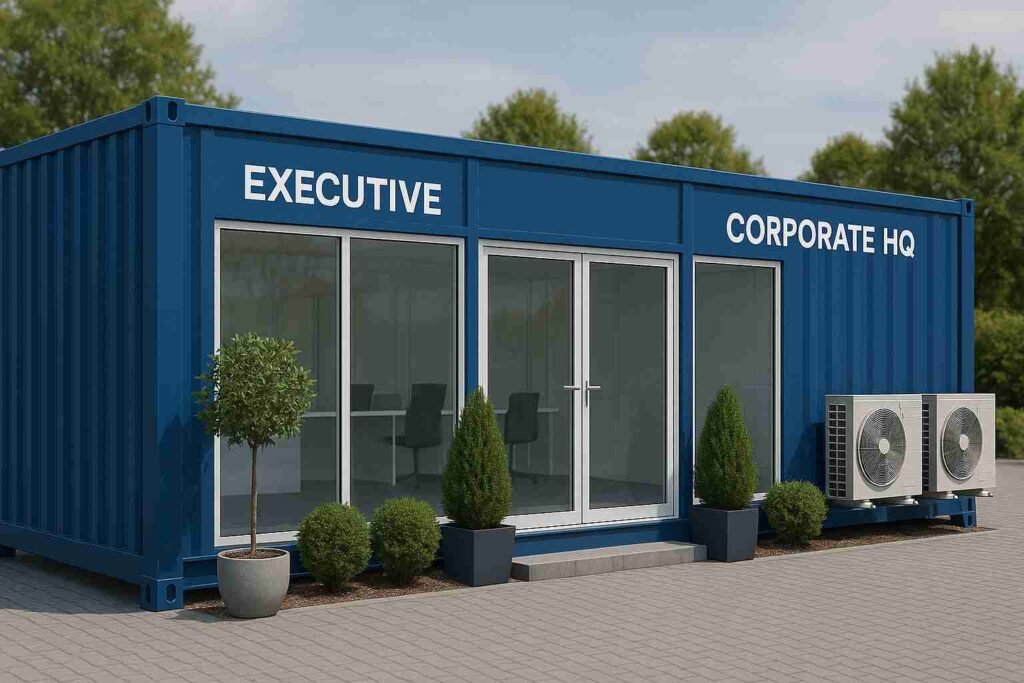
Most buyers expect a single figure when they ask for container offices price India. However, a guard room, a sales office, and a project HQ each come with very different costs. Understanding breakdowns is essential to budget realistically.
A sales office requires interiors, branding, HVAC, and partitions. A guard cabin may need only flooring, wiring, and windows. This is why prices range widely. Without context, quotes appear confusing or misleading.
Real cost also includes indirect elements like compliance, insurance, and documentation. Certified suppliers include these in their quotes. Low-cost vendors often ignore them, creating budget shocks later. Smart buyers always demand complete breakdowns with hidden costs revealed upfront.
Per Square Foot Costs: How to Compare Smarter in 2025
In 2025, container offices usually cost ₹800–1,150 per square foot. The range depends on insulation, interiors, and finishing. Bare-bones shells sit near ₹800, while premium insulated cabins sit near ₹1,150.
For comparison, brick offices in metros cost ₹2,000–2,500 per square foot. That makes container offices 30–40% cheaper. Moreover, they deliver in weeks rather than months, which accelerates ROI.
Therefore, container offices price India should always be compared per square foot. It allows buyers to judge efficiency, capacity, and ROI against alternatives. This method highlights value beyond initial investment.
Unit Pricing Revealed: From ₹1.7 Lakh Basics to ₹15 Lakh Premiums
Unit pricing gives buyers clear categories. Basic 20-foot cabins cost ₹1.7–2.5 lakh. These include vinyl flooring, wiring, and windows. They are ideal for guard cabins or compact site teams.
Standard units of 30–40 feet cost ₹3–6 lakh. These add partitions, AC, restrooms, and basic branding. They are perfect for mid-size site HQs or real estate offices.
Premium cabins reach ₹8–15 lakh. They include glass façades, branded interiors, HVAC, and executive layouts. They are designed for client-facing sales offices and corporate-grade site headquarters.
Hidden Costs That Buyers Often Miss (and How to Avoid Them)
Table: Don’t forget these add‑ons when comparing quotes.
| Cost Component | Approximate Range (₹) | Notes |
| Transport | 30,000–70,000 | Distance, permits, route complexity |
| Foundation (Gravel/RCC) | 20,000–1,00,000 | Gravel for short stays; RCC for long‑term stability |
| Cranes & Installation | 20,000–50,000 | Lifts, leveling, and anchoring |
| Utility Connections | 10,000–30,000 | Power, water, internet readiness |
Sticker prices exclude many necessary costs. Buyers often forget delivery, installation, and foundations. Ignoring these adds 10–20% to the project budget.
Gravel pads may cost ₹20,000. RCC slabs cost up to ₹1 lakh. Transport for 40-foot cabins adds ₹30,000–₹70,000 depending on distance. Installation cranes and drainage add another ₹20,000–₹50,000.
Utility connections also matter. Power, internet, and water add ₹10,000–₹30,000. Therefore, container offices price India must always include these items in quotes. Without them, budgets collapse under hidden charges.
Basic vs Standard vs Premium: Which Container Office Fits Your Project?
Table: Choose the right category by matching features, price band, and usage.
| Category | Size | Features | Price Range (₹) | Best Use Case |
| Basic | 20 ft | Vinyl flooring, wiring, windows | 1.7–2.5 lakh | Guard cabins; compact site offices |
| Standard | 30–40 ft | Partitions, AC, pantry/restroom | 3–6 lakh | Site HQs; developer offices |
| Premium | 40 ft+ | Glass façade, branded interiors, HVAC | 8–15 lakh | Sales counters; executive hubs |
Each category serves a unique purpose. Basic cabins fit small-scale projects. Standard cabins provide comfort and professionalism. Premium cabins deliver polished image and corporate-grade functionality.
A ₹2 lakh basic cabin is not meant to impress clients. It is functional and temporary. A ₹5 lakh standard office balances affordability with quality. A ₹12 lakh premium unit signals professionalism in client-facing projects.
This shows why quotes vary. Buyers must match features to project goals. The container offices price India should always reflect actual needs, not generic averages.
Why Location Can Add 15% to Your Container Office Price in India
Regional variation creates price differences. A cabin costing ₹2 lakh in Bangalore may cost ₹2.3 lakh in Delhi due to logistics and municipal compliance. Transport charges significantly influence price.
In Mumbai, land and crane rentals raise costs further. Tier-II cities offer cheaper builds but with limited customization options. Location therefore has a direct impact on container offices price India.
Resale also varies by city. Premium demand in metros ensures faster recovery. In smaller towns, resale may take longer. Buyers should localize cost and recovery calculations regionally.
Rental vs Purchase: The Payback Truth Most Contractors Ignore
Table: Ownership usually wins across a 3‑year view due to resale recovery.
| Option | 3‑Year Outflow (₹) | Resale Recovery (₹) | Effective Net Cost (₹) |
| Rental (₹20,000/month) | 7,20,000 | 0 | 7,20,000 |
| Purchase – Basic | 5,00,000 | 2,50,000 | 2,50,000 |
| Purchase – Standard | 7,00,000 | 3,50,000 | 3,50,000 |
Rentals appear cheaper monthly but drain capital long-term. A 20-foot cabin may rent for ₹20,000. Over three years, that totals ₹7.2 lakh with zero recovery value.
Purchasing at ₹5 lakh provides usage plus resale. At 50–70% recovery, effective cost drops to ₹2–3 lakh. Ownership therefore beats rentals every time.
Contractors often regret rentals after projects. Lifecycle math shows ownership delivers better ROI. Thus, container offices price India must always be evaluated over years, not months.
Rental vs Purchase: The ROI Equation
On the surface, rentals look affordable. In practice, they drain budgets without leaving behind an asset.
| Option | 3-Year Outflow | Resale Recovery | Effective Net Cost |
| Rental (India) | ₹7.2 lakh (₹20,000/month) | ₹0 | ₹7.2 lakh |
| Purchase – Basic | ₹5 lakh | ₹2.5 lakh (50%) | ₹2.5 lakh |
| Purchase – Standard | ₹7 lakh | ₹3.5 lakh (50%) | ₹3.5 lakh |
| Rental (Global) | $14,400 (€13,000) at $400/month | $0 | $14,400 |
| Purchase – 40 ft Office | $15,000 (€13,500) | $7,500 resale | $7,500 |
Key Insight: Whether in India or abroad, ownership delivers 50–70% cost recovery. Rentals, by contrast, leave nothing behind.
👉 Lesson: Smart contractors compare lifecycle math, not just monthly bills.
2025 Outlook: Pricing Trends
- India: Stable prices expected — Basic ₹1.7–2.5 lakh, Standard ₹3–6 lakh, Premium ₹8–15 lakh.
- Global: Steel price stabilization keeps container shells between $1,500–$6,000 depending on size and condition.
- Market Drivers:
- Demand from real estate & renewable projects will stay strong.
- Logistics costs (crane rentals, transport) may rise slightly in metros and ports.
- Certifications will play a larger role in tenders.
👉 Takeaway: 2025 is a favorable year for procurement. Predictable pricing + strong resale markets mean buyers can lock in predictable ROI.
Case Studies That Prove the Numbers Don’t Lie
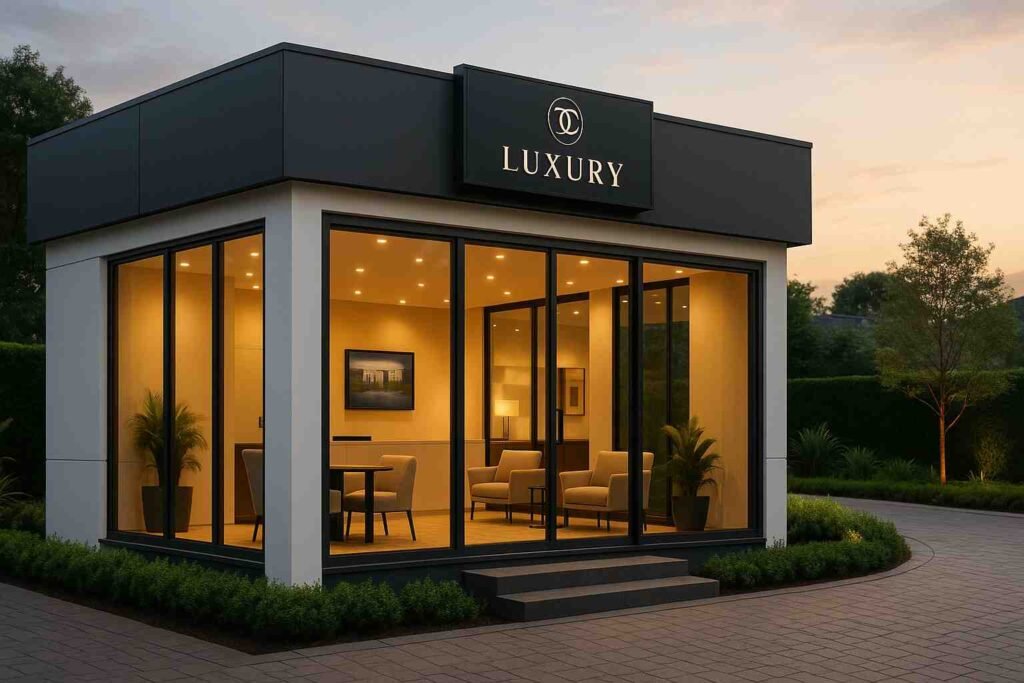
A Bengaluru developer invested ₹6 lakh in a branded sales office. Sales launched four months early. Resale later recovered ₹3.5 lakh. Effective cost was only ₹2.5 lakh.
Delhi Metro installed ₹10 lakh worth of offices. After three years, resale returned 55% of cost. Rentals would have cost almost double.
A Maharashtra contractor purchased a ₹12 lakh HQ. After five years of use, resale recovered ₹6 lakh. Effective cost halved, proving ownership delivers stronger ROI.
Transparent Pricing: The Secret to Winning Buyer Trust in India
Indian buyers dislike vague quotes. Transparent suppliers who share breakdowns win confidence. Clarity about hidden charges prevents disputes and builds long-term credibility.
When buyers see lifecycle cost, resale potential, and compliance included, they trust the supplier. Transparency turns container offices from a risky purchase into a strategic asset.
Therefore, the container offices price India must never be seen as just a number. It is a financial plan, tied to ROI, credibility, and project outcomes.
The Long-Term Financial Picture
The container offices price India may appear high upfront, but the financial story unfolds over years. Container offices cut energy bills, reduce downtime, and resell strongly. Their total cost of ownership makes them 30–40% cheaper than brick buildings.
Payback cycles of 24–36 months are standard, with some projects breaking even in just 18 months. When buyers calculate lifecycle value, container offices consistently outperform rentals and traditional builds. The long-term financial picture is what sets them apart.
Total Cost of Ownership Explained
Most buyers only look at purchase price. But true cost includes energy, maintenance, downtime, and resale. This total cost of ownership (TCO) defines real financial impact. Ignoring it risks false savings and expensive mistakes.
For example, a ₹7 lakh office may seem steep compared to rentals. But when energy savings and resale are included, its effective cost falls to ₹2–3 lakh. Rentals never offer such recovery. Ownership always wins in lifecycle math.
Indian procurement teams are learning to ask for TCO models in tenders. They want numbers that include five-year operating costs, not just the day-one price. Suppliers who provide this transparency gain trust and repeat orders.
Energy Savings That Compound Over Years
Insulation may raise upfront cost. But it lowers electricity bills for years. Glass wool, rock wool, or PUF panels reduce cooling loads by 15–30%. Over long Indian summers, this difference saves lakhs in operating budgets.
Consider a Gujarat solar park. Rock wool insulation cut HVAC energy consumption significantly. Electricity bills dropped 25% compared to non-insulated cabins. Over two years, energy savings alone paid for one-third of office cost.
This is why container offices price India must always include energy analysis. Buyers who ignore insulation think they saved initially. Later, they overspend heavily on monthly bills. Smart buyers calculate lifecycle energy performance.
Maintenance Costs: Low But Predictable
Container offices need minimal upkeep. Corten steel resists rust. FR cables reduce fire risk. Vinyl or laminate flooring cleans easily. Regular painting and sealing every 3–4 years keeps structures stable for decades.
Compared to brick offices that crack, leak, or require major repair, container offices are cheaper to maintain. Annual expenses remain small and predictable. This protects budgets and avoids sudden repair shocks during projects.
When procurement teams assess container offices price India, they should ask about maintenance schedules. Certified suppliers provide clear guidance. Lifecycle maintenance planning ensures stability, resale value, and project continuity.
Resale Value: Protecting Capital at Exit
Unlike rentals, container offices retain strong resale demand. Used units often recover 50–70% of original price after three years. In India’s active prefab market, resale takes as little as 30–60 days.
A Bengaluru developer resold their sales office for ₹3.5 lakh within 45 days. They had originally spent ₹6 lakh. Effective usage cost was just ₹2.5 lakh. No rental could deliver such recovery.
Therefore, resale is not an afterthought. It is a pillar of financial planning. When analyzing container offices price India, resale recovery must be added into ROI models. It changes the numbers completely.
Payback Cycles That Beat Traditional Builds
Most container office projects recover costs in 24–36 months. Intensive-use sites, like real estate sales offices, sometimes break even in 18 months. Faster revenue starts are the biggest driver of this quick ROI.
Brick buildings can take years before payback. Rentals never pay back at all. Container offices accelerate cash flow, making them the preferred choice for capital-sensitive Indian businesses.
This is why tenders increasingly include ROI models in evaluation. Procurement officers want suppliers to prove payback periods. The container offices price India gains credibility when supported by real financial math.
Why Rentals Fail in Long-Term Math
Rentals appear cheap at first glance. Monthly charges look manageable. But over time, they drain budgets. A ₹20,000 rental over three years adds up to ₹7.2 lakh with no asset value left.
By contrast, ownership at ₹5 lakh provides usage plus resale. Even with resale at 50%, effective cost is less than ₹3 lakh. Rentals can never match this balance of use and recovery.
Many contractors regret rentals after projects. They realize late that ownership would have protected capital. That is why serious buyers always compare rentals with ownership when studying container offices price India.
Downtime Costs: The Hidden Drain
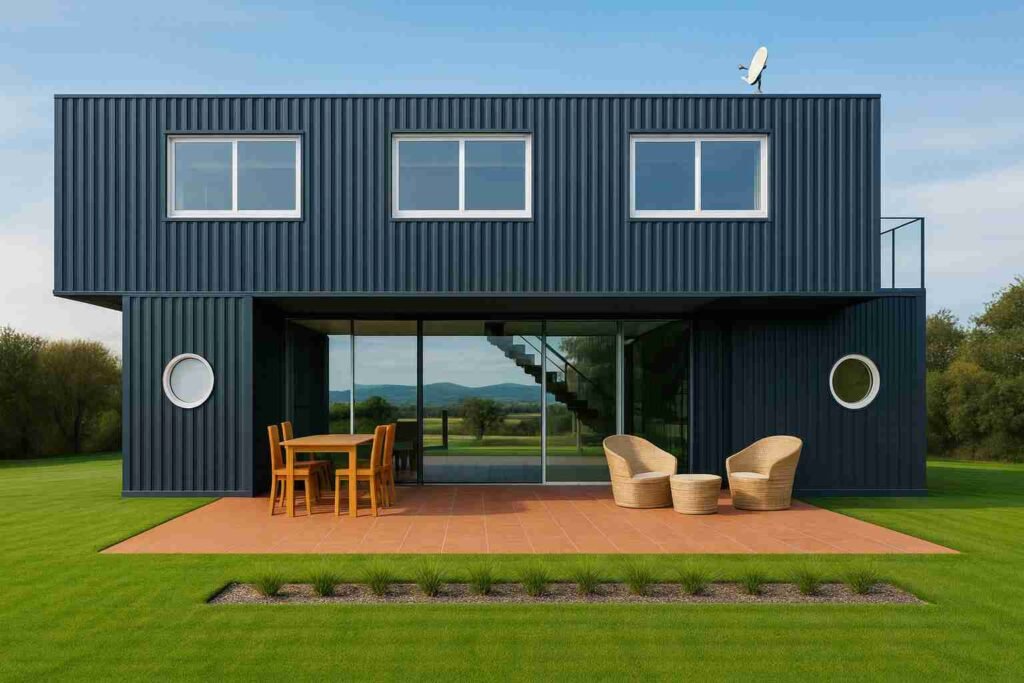
Traditional builds face frequent delays. Weather, labor strikes, or material shortages stop progress. Each month lost damages cash flow and reputation. Container offices avoid this risk with parallel off-site fabrication.
For example, while sites are being leveled, container fabrication continues in factories. This overlap saves months. Projects launch on time. Early openings create faster revenue streams.
The true container offices price India must include this advantage. Time is money. Saving months equals saving lakhs. Downtime avoided is one of the strongest financial benefits.
Compliance and Tender Eligibility as Financial Leverage
Many Indian tenders now demand compliance. ISO, CSC, and fire safety certificates are mandatory. Non-compliant offices risk rejection. That rejection means lost contracts and lost revenue.
Certified container offices cost slightly more upfront. But they ensure smooth approvals. They avoid penalties and project stoppages. This compliance advantage translates directly into financial savings.
Therefore, buyers should see compliance as part of price. The container offices price India may rise by 10%. But that 10% protects entire contracts worth crores. It is financial leverage, not expense.
Investor Confidence and Business Image
Investors and clients notice office quality. A polished container office signals professionalism. It reassures stakeholders about safety, compliance, and delivery. This reputation creates easier funding and faster client approvals.
For startups and contractors, credibility can decide survival. Cheap porta cabins weaken image. Branded container offices strengthen trust. That trust leads to more contracts and better investor terms.
The financial picture is not just numbers. It includes perception. The container offices price India often buys credibility. And credibility multiplies business returns beyond the project.
The Long-Term Edge Over Traditional Buildings
Over decades, container offices outcompete brick builds. They are movable, flexible, and resale-ready. Traditional offices tie up capital permanently. Container offices keep capital fluid and mobile.
Maintenance and energy savings add compounding benefits. Predictable costs improve budgeting. Resale protects exit capital. For Indian firms facing tight timelines, these advantages make container offices unbeatable.
Therefore, the container offices price India should always be studied as a lifecycle number. When seen this way, container offices emerge as the superior financial decision every time.
Global + India FAQs
Global FAQs
Q1. How much does a container office cost worldwide?
- Used 20 ft: $1,500–$3,000 | €1,300–€2,700
- New 40 ft: $3,500–$6,000 | €3,200–€5,500
- Modifications: $5,000–$20,000 depending on interiors and HVAC.
Q2. Is it better to rent or buy globally?
- Rentals: $400–$800/month (€350–€700).
- Ownership: $12,000–$18,000 with 50–70% resale recovery after 3 years.
👉 Ownership usually wins unless the project is <6 months.
Q3. What approvals are needed outside India?
- U.S.: OSHA + state building/zoning permits.
- Europe: CE Marking, EN safety standards.
- Middle East: Civil Defence NOCs + municipality permits.
India FAQs
Q1. What is the typical price band in 2025?
- Basic: ₹1.7–2.5 lakh (20 ft).
- Standard: ₹3–6 lakh (30–40 ft).
- Premium: ₹8–15 lakh (40 ft+).
Q2. Why do quotes vary by city?
Transport, crane rentals, and municipal compliance add costs. Bangalore ~₹2 lakh, Delhi NCR ~₹2.3 lakh, Mumbai higher due to logistics.
Q3. Is insulation worth it in India?
Yes. Saves 15–30% electricity, improves comfort, boosts resale. Pays back in 2–3 years.
Q4. How fast is delivery?
Standard cabins: 4–6 weeks. Custom branding: +1–2 weeks.
Q5. Rent vs Buy in India?
- Rental: ₹20,000/month → ₹7.2 lakh in 3 years, no recovery.
- Purchase: ₹5 lakh → resale recovers ₹2.5–3.5 lakh, effective cost halved.
Q6. What documents are mandatory?
ISO/CSC plates, fire safety, electrical compliance, and structural drawings. Needed for tenders and resale.
Q7. What foundations should be planned?
- Short-term: Gravel pads (~₹20,000).
- Long-term: RCC slabs (~₹1 lakh). Drainage critical in monsoons.
Q8. How to forecast ROI?
Typical payback: 24–36 months. Real estate offices: 18 months possible.
Q9. How to judge supplier credibility?
Look for transparent line-item quotes, valid certifications, past project photos, and warranty coverage.
Next Steps
Define headcount, layout, insulation, and duration of use before requesting quotes. Always ask for full cost sheets that include delivery, installation, compliance, and documentation. This ensures apples-to-apples comparison and avoids hidden costs.
For detailed consultation and quotations, connect with Saman Portable directly.














